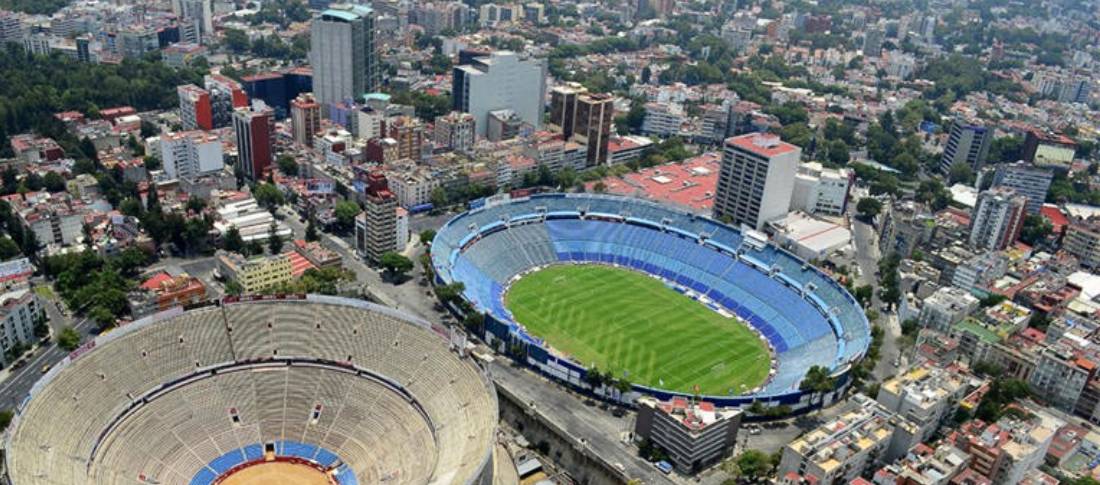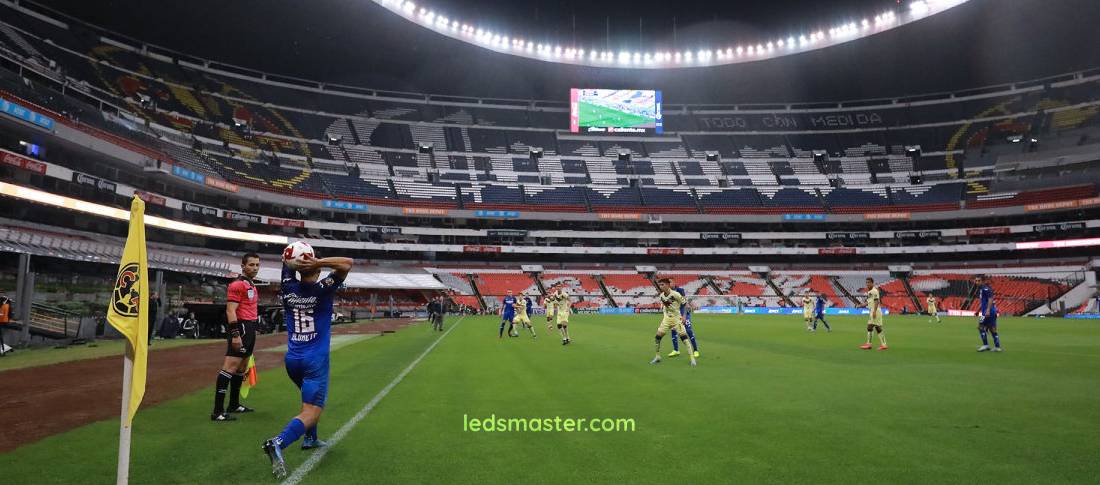Cruz Azul Stadium, also renowned as Estadio Azteca, holds a distinguished place among Mexico’s most iconic football venues. Nestled in the vibrant heart of Mexico City, this stadium epitomizes the city’s rich sporting culture and the fervent passion of its football fans. Since its grand inauguration in 1966, the stadium has not only been a crucial home ground for the Cruz Azul football club but has also played host to numerous historic matches and major sporting events.
Over the decades, it has undergone a series of renovations and modernizations, transforming from its original design into a state-of-the-art facility. These updates have ensured that the stadium remains at the forefront of modern sports venues, capable of accommodating both local and international events with unparalleled excellence. This article offers a comprehensive exploration of the stadium’s architectural marvels, its sophisticated lighting design, and the profound impact it has on the community and cultural landscape of Mexico City. Through this in-depth look, we will uncover how Cruz Azul Stadium continues to be a beacon of sportsmanship and cultural pride.
Table of Contents
ToggleLocation and Accessibility

Cruz Azul Stadium is strategically situated in the southern part of Mexico City, a bustling and dynamic area renowned for its vibrant atmosphere and exceptional accessibility. This prime location provides numerous advantages for both local supporters and visiting fans. The stadium benefits from its proximity to major roadways, which facilitate smooth vehicular access and ease of travel. Additionally, the area is well-served by an extensive public transportation network, including buses and a nearby metro station, which offers direct and efficient access to the stadium. This connectivity is crucial for accommodating the large volumes of spectators that flock to the venue for various events.
Surrounding the stadium, the neighborhood is rich with amenities that greatly enhance the visitor experience. The area boasts a diverse range of hotels, from luxurious to budget-friendly options, ensuring that accommodations are available to suit different preferences and budgets. For dining, numerous restaurants and cafes offer a variety of culinary options, allowing fans to enjoy pre- or post-match meals in a vibrant and social setting. Furthermore, the presence of shopping centers and entertainment venues nearby adds to the appeal, providing additional options for leisure and convenience. This comprehensive array of services and facilities ensures that attending an event at Cruz Azul Stadium is not just a sporting experience but a well-rounded visit to one of Mexico City’s lively and accessible districts.
Architectural Features
Cruz Azul Stadium’s architecture stands as a remarkable testament to both its historical significance and its ongoing evolution. Originally conceived and designed by the renowned architect Pedro Ramírez Vázquez, the stadium showcases a circular structure that is both iconic and functional. The design features a distinctive overhanging roof that not only enhances the stadium’s aesthetic appeal but also serves a practical purpose. This expansive roof provides comprehensive coverage for the seating area, ensuring that spectators are protected from the elements, whether it’s the intense sun or inclement weather, thus enhancing the comfort and enjoyment of every event.
With a capacity exceeding 87,000 spectators, Cruz Azul Stadium ranks among the largest stadiums in the world. Its architectural design is characterized by a series of concentric rings, which create a visually striking layered effect. This thoughtful design facilitates an immersive viewing experience for fans. The upper tiers are strategically positioned to offer expansive, panoramic views of the playing field, allowing spectators to enjoy the game from a broad perspective. Meanwhile, the lower tiers are designed to bring fans closer to the action, fostering a more intimate and exhilarating atmosphere. This combination of architectural elements ensures that every seat in the stadium provides an excellent view of the pitch, making it a truly inclusive venue where every spectator can experience the excitement of the game firsthand. The design not only underscores the stadium’s grandeur but also exemplifies a commitment to enhancing the overall fan experience, blending aesthetic beauty with functional excellence.
Lighting Features
Lighting Design and Technology
Over the years, the stadium’s lighting system has undergone substantial advancements, reflecting a commitment to incorporating cutting-edge technology that improves both the match-day experience and broadcasting quality. These advancements ensure that the stadium remains at the forefront of modern sports venues, catering to the evolving needs of players, spectators, and media alike.
The current lighting setup features state-of-the-art high-intensity LED floodlights, meticulously positioned around the stadium to deliver optimal illumination across the entire pitch. These LED lights are engineered to provide uniform lighting, eliminating shadows and ensuring that every corner of the playing field is brightly lit. This level of illumination is crucial for maintaining visibility and clarity for players, referees, and spectators, particularly during evening matches or under adverse weather conditions. The uniformity of the lighting enhances the overall viewing experience, allowing fans to enjoy the game without any visual distractions.
In addition to improving visibility, the adoption of LED technology brings significant operational benefits. LED lights are renowned for their energy efficiency, consuming far less power compared to traditional halogen lights. This reduction in energy consumption not only lowers the stadium’s operational costs but also aligns with broader sustainability goals by reducing the environmental impact. Furthermore, LEDs require less frequent maintenance and have a longer lifespan, which translates to lower maintenance costs and fewer disruptions. This technological upgrade represents a substantial improvement over the earlier halogen lighting systems, marking a forward leap in the stadium’s commitment to providing a high-quality experience while maintaining operational efficiency.
Dynamic Lighting Effects
In addition to its core illumination capabilities, Cruz Azul Stadium incorporates a sophisticated array of dynamic lighting effects designed to elevate the atmosphere and enhance the overall spectator experience during events. This advanced lighting system is managed through a state-of-the-art control interface that offers a wide range of visual displays, including the ability to adjust colors and create intricate light patterns. This flexibility allows for the creation of vibrant and immersive lighting environments that can adapt to various types of events and occasions.
During key moments of a match, such as goal celebrations or halftime shows, the lighting system can be programmed to produce dramatic and eye-catching effects. For instance, when a goal is scored, the stadium lights can shift through a spectrum of colors and patterns, amplifying the excitement and emotional impact of the moment. Similarly, during halftime or special events, the lighting can be used to craft elaborate visual displays that captivate the audience and add a layer of entertainment beyond the game itself.
The ability to create these dynamic effects contributes significantly to the overall atmosphere of the stadium. By integrating visual elements that respond to the action on the field, the lighting system enhances fan engagement and creates a more immersive experience. This dynamic approach not only makes each event memorable but also helps to build a stronger connection between the stadium and its visitors. The sophisticated lighting control system thus plays a pivotal role in transforming ordinary moments into extraordinary experiences, reinforcing Cruz Azul Stadium’s reputation as a premier venue for both sporting events and entertainment.

Community and Cultural Impact
Social and Economic Contributions
Cruz Azul Stadium occupies a central and influential role within the local community, functioning as a vibrant hub for a wide array of cultural and social activities. While its primary function is to host thrilling football matches, the stadium’s impact extends far beyond the realm of sports. It regularly serves as a venue for concerts, cultural festivals, and various community gatherings, making it a versatile and dynamic space that caters to diverse interests and events. These activities significantly contribute to the local economy by generating employment opportunities and stimulating business for surrounding establishments, including hotels, restaurants, and retail stores. The influx of visitors for different events helps to sustain and grow the local economy, highlighting the stadium’s importance as a key economic driver.
Moreover, Cruz Azul Stadium is a profound source of identity and pride for the residents of Mexico City. As the cherished home ground of the Cruz Azul football club, the stadium stands as a monument to the team’s rich history and achievements. This association fosters a deep sense of local pride and communal spirit, with the stadium symbolizing not just a venue but a storied legacy of football excellence. The passionate and loyal support of the fans creates an electric atmosphere that extends beyond match days. The fervor and enthusiasm of the crowd become a defining feature of the city’s cultural landscape, infusing every event with a unique and celebratory energy. This sense of community pride is reflected in the collective celebrations and local traditions that are intertwined with the stadium’s events, further embedding Cruz Azul Stadium into the cultural fabric of Mexico City.
Environmental and Sustainability Efforts
In recent years, there has been an increasing focus on environmental sustainability across various sectors, and stadium operations are no exception. Cruz Azul Stadium has embraced this shift by implementing a range of measures designed to minimize its environmental footprint and promote eco-friendly practices. These initiatives are part of a broader trend within the sports industry toward more responsible and sustainable resource management.
One of the key areas of focus for Cruz Azul Stadium has been the adoption of energy-efficient lighting systems. By transitioning to advanced LED technology, the stadium has significantly reduced its energy consumption and associated carbon emissions. LED lights not only provide superior illumination but also consume less power and have a longer lifespan compared to traditional lighting options. This shift contributes to substantial energy savings and supports the stadium’s commitment to reducing its overall environmental impact.
In addition to energy-efficient lighting, Cruz Azul Stadium has implemented waste reduction programs designed to minimize the amount of waste generated during events. These programs include comprehensive recycling initiatives, which aim to divert recyclable materials away from landfills and encourage more sustainable waste management practices. The stadium has also introduced measures to reduce single-use plastics and increase the use of reusable or biodegradable materials, further supporting its environmental goals.
Water conservation is another critical area of focus for the stadium’s sustainability efforts. Cruz Azul Stadium has adopted water-saving technologies and practices, such as low-flow fixtures and efficient irrigation systems, to reduce water consumption. These measures help to ensure that the stadium’s operations are as environmentally responsible as possible, aligning with broader water conservation goals.
The stadium’s commitment to these sustainability measures reflects a growing awareness within the sports industry of the importance of environmental stewardship. By integrating these practices into its operations, Cruz Azul Stadium not only contributes to the preservation of natural resources but also sets an example for other venues and organizations. This dedication to sustainability underscores a broader movement toward greener practices and highlights the role that sports venues can play in promoting environmental responsibility.
Conclusion
Cruz Azul Stadium stands as a testament to architectural innovation and modern lighting design. Its strategic location, iconic design, and advanced lighting system make it a landmark in Mexico City. The stadium’s impact extends beyond football, influencing the community and contributing to the local economy and culture. As it continues to evolve, Cruz Azul Stadium will undoubtedly remain a central figure in the sporting and cultural landscape of Mexico.

